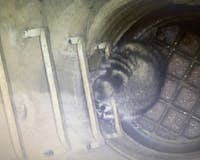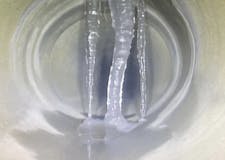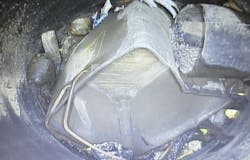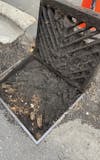CCTV
What is the purpose of CCTV?
It is important to perform routine pipe inspections to ensure that sewage systems are functioning properly.
CCTV is a preventative measure that keeps you confident in the integrity of your pipes and informs you in the event of cracks, intrusions, offset joint, and other pipe damages so that the proper measures can be taken to prevent serious damage and overflow.
What is the largest pipe size Wessuc can inspect?
Wessuc can inspect pipes up to 5080mm (almost 17ft) in diameter!
When is it time to inspect?
Oftentimes CCTV will be part of a regular maintenance plan or schedule for a municipality. It is also recommended for developers to complete inspections before developing new subdivisions, and for manufacturing facilities that suspect changes in their infrastructure to look into a CCTV inspection.
What is required before getting started?
Maps of the infrastructure are ideal for helping our teams know what areas may require attention.
For municipalities, it is important to know the type of access, upstream or downstream manhole, and if there is a GIS system (Geographic Information System Map).
What is the craziest thing Wessuc has found in a pipe?
Our crews at Wessuc have found some pretty bizarre things during our pipe inspections. There have been raccoon sightings, some icicles, a garbage blockage, and even a storm drain that was filled with dirt.
Inspecting your pipes fills our day with surprises.




Flushing
What is the purpose of flushing?
It is important to flush pipes to clear out and properly dispose of any debris that has built up. Debris is harmful because it hinders or prevents pipe flow which can damage sewer systems or lead to overflow. Therefore, flushing is a method to restore pipe flow, maintaining pipe integrity, and allowing for pipe inspection to occur.
Wessuc’s flusher has a powerful recycling system that reclaims water to clean sewers in an environmentally friendly manner while saving your municipalities money.
How does flushing work?
Flushing trucks have hoses that spray pressurized water through pipelines to remove debris blockage. The debris is then air vacuumed into our 12 yard debris tank to prevent it building up elsewhere in the pipe.
What is the largest pipe size Wessuc can flush?
Wessuc can flush pipes up to 1350mm (4ft) in diameter!
What pressure do our flushers use to clean pipes?
Wessuc's flushers use water pressures varying from 400 to 1500 PSI depending on the pipe size and debris.
Reaming & Cutting
What is the purpose of reaming?
Reaming is used to clean a pipeline by the removal of hardened debris such as sand and grease. It allows for proper inspection to occur by removing obstructions that could block or hinder the camera. Reaming is faster than cutting as it removes obstructions around the entire pipe circumference simultaneously.
How does reaming work?
Reaming uses an attachment which is secured to a nozzle on the flusher hose that rotates to remove hardened debris as it travels through the pipe.
What kind of pipe defects can you fix with a cutter?
A cutter can be used to remove hardened deposits such as calcite, tree roots, and concrete, to remove exposed gaskets, to smoothen protruding off-set joints, to trim back lateral intrusions, and to reopen laterals after spot repair.
How are cutters controlled?
The cutting unit is monitored by CCTV and controlled by an operator from the cutting truck. The camera locates the obstructions and the operator uses the cutter to cut away the intrusion, restoring proper pipe flow and smoothening the pipe.
What is the difference between cutting and reaming?
Reaming involves adding an attachment, such as a chain, to a specific nozzle on a flusher truck to smash or chop whatever obstructions are within the pipe as the hose is pulled back through it.
Cutting is more precise, using a robot to focus on a specific problem or intrusion in the pipe.
When should you ream versus cut pipe?
Reaming is often done in conjuction with flushing to remove obstructions from the pipe, cleaning and restoring the flow. Cutting is applicable to remove hard debris that the reamer could not dislodge. Cutting may also be necessary when the pipe size or condition is unsuitable to reaming as cutting offers more precise obstruction removal.
Grouting
What kind of infiltrations can you repair?
We can repair dripping, running and gushing infiltrations.
What grout material does Wessuc use?
At Wessuc, we use the Avanti-100 chemical sealant to repair your sewer leaks. This sealant is a safe, economical, and reliable fix.
How is grouting related to cutting?
Cutting is often the precursor to grouting. After the pipe is been cleaned, inspected, and imperfections are cut away, grout material is inserted into any cracks to prevent or stop intrusions. A good analogy is to think of cutting as sanding a piece of furniture before painting, and grouting is your wood filler to fill imperfections.
How is grouting related to spot repair?
Grouting is necessary to stop infiltration before lining or spot repair is done. Any leak that is still active creates a bubble or wrinkle in the liner. After a liner is installed and laterals are cut out or ‘reinstated’, grouting of that annular space needs to be done.
Spot Repair
What pipe sizes can you repair?
We can install short liner spot repairs in pipe size ranging from 150mm to 600mm diameter.
How long are Wessuc's spot repairs?
Our short liner spot repairs can cover 1-2 meters of defective pipe.
How long is the cure time?
Our UV cured patch repair technology needs only 8 minutes per repair.
How does it work?
Imagine a cylindrical balloon that is wrapped with a resin and transferred through the inside of a pipe to the imperfection. The balloon then gets inflated, and the resin is cured to the inside of the pipe using a UV light. Once cured, the finished product is equivalent in strength to a PVC pipe.